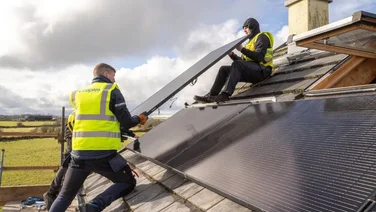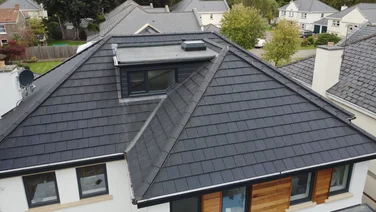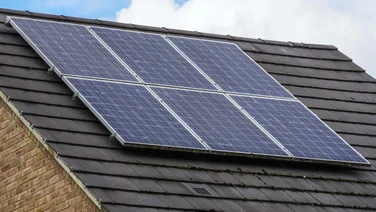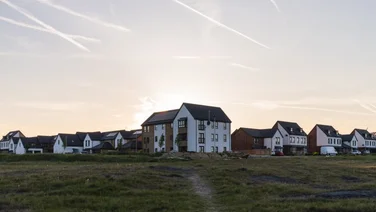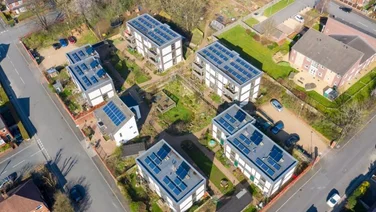- Do solar panels in the UK have to be south-facing?
- How much power do north-facing solar panels produce?
- Is it worth installing solar panels if you only have a north-facing roof?
- What is the ideal angle and direction for solar panels in the UK?
- What’s the ideal solar panel situation in the southern hemisphere?
- Summary
✔ In the UK, south-facing solar panels receive the most sun exposure
✔ North-facing solar panels receive the least sun exposure
✔ If your roof isn’t suitable, ground-mounted solar panels could be an option
The ideal positioning of solar panels to produce the greatest amount of energy depends on where you live. The best angle and direction for solar panel installation in the UK, whether that be roof-mounted, ground-mounted or shed-mounted, is always recommended to be south-facing.
As the UK is in the northern hemisphere, south-facing panels will receive the most sun exposure throughout the day and, therefore, will produce more solar energy. However, this doesn’t mean that north-facing solar panels are fruitless.
If you’re wondering what your options are for installing solar panels on your home, you can complete our free online form and receive a free quote from our specialists.
Where do you want to install solar panels?
Get started
Do solar panels in the UK have to be south-facing?
There is no policy or legislation in the UK that states where solar panels must be placed. However, there are benefits of having solar panels placed in a certain position.
The aspect of a solar panel determines its efficiency. In the UK, it is recommended that solar panels are installed in a south-facing position in order to optimise sun exposure and therefore, maximise energy output.
This is because the sun rises in the east and sets in the west, meaning that panels facing a southerly direction will have the most sunlight exposure during the day.
How much power do north-facing solar panels produce?
For a typical 3kWp solar photovoltaic (PV) system, north-facing panels will produce approximately 1,145 kWh of electricity per year, compared to, say, 1,361 kWh for a south-facing installation. So, north-facing panels don’t produce zero energy, but it is considerably less.
How does this differ from south-facing solar panels?
The maximum yield from a north-facing solar panel in the UK is about 60%, compared to 80%-100% for south-facing panels.
Where do you want to install solar panels?
Get started
Is it worth installing solar panels if you only have a north-facing roof?
While south-facing solar panels are recommended for properties in the UK, north-facing panels will still produce energy, but there will be a noticeable reduction in comparison to south-facing panels. In order to compensate for this, a larger collection of panels may be necessary. The time it will take for your PV system to pay back your investment will also be at least four years longer.
The orientation of solar panels is a significant factor in regard to their efficiency, but other factors also affect energy production. These include the level of shading, the angle of the panels, the size of the installation, and the shape and size of the panels.
Another noteworthy consideration is the quality of the panels used. For example, monocrystalline solar panels are made from one pure silicone crystal and are considered to be the most effective at producing solar energy. However, they are the most expensive panel to purchase and install.
Alternatives to a north-facing roof
Although roof-mounted is the most common domestic method of solar panel installation, there are other alternatives if you have limited roof space, a structurally weak roof, or a roof that doesn’t face south.
Ground-mounted solar panels are fixed into the ground via a racking system and are usually positioned slightly above the ground. They are traditionally found in large numbers, for example on solar farms.
This method of installing solar panels is typically more expensive than roof-mounted panels, but they tend to be more efficient as they can be oriented and angled accurately to achieve the most sun exposure. Furthermore, they are easier to clean and maintain in comparison to roof-mounted panels.
If ground- or roof-mounted panels are not feasible, you could consider installing panels on your shed. Mounting solar panels on a shed, or a similar structure, is a very similar process to installing them on a residential house. However, the structural integrity must be assessed before installation as shed roofing tends to be weaker.
What is the ideal angle and direction for solar panels in the UK?
As previously discussed, the angle of your solar panels is important. An accurately angled solar panel maximises its efficiency due to longer exposure to the sun during the day.
In the UK, the best angle and direction for a solar panel is between 20 and 50 degrees and south-facing. If the pitch of a panel falls out of this range it still generates energy, but not as efficiently.
What’s the ideal solar panel situation in the southern hemisphere?
As the UK is in the northern hemisphere, pointing your solar panels towards the south is advantageous, as they will face the equator.
So, what about those who live in the southern hemisphere? The answer is simple. Those who live in countries such as South Africa, Australia, or Argentina should preferably have their solar panels in a northern-facing position (i.e. facing the equator) in order to maximise their exposure to sunlight during the day.
Summary
If you are considering installing a solar PV system, it is important to understand how solar panels work and what conditions are required to maximise their output. There is an obvious difference between north and south facing solar panels in the UK, with south-facing solar panels between a 20 and 50 degree angle being the most preferable position.
Again, this doesn’t mean that solar panels in a northern orientation are obsolete, but they will not produce as much solar energy as those that face south.

